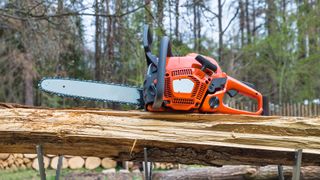If you’re not only looking for a new chainsaw bar or chain but are considering buying an entirely new chainsaw, don’t forget to check out our guide to the best chainsaws (opens in new tab)you can buy in 2022. We’ve included a wide variety of chainsaws, with the top brands including Stihl, Oregon, Kobalt and Echo. If you’ve already got a purchase in mind, it’s also worth exploring cheap chainsaw deals (opens in new tab) so you can find the right model, at the right price. In the meantime, we’ve found the best tips to teach you how to measure a chainsaw bar and chain, so you can easily complete the tasks at home.
How to measure a chainsaw bar
It can seem a daunting task to measure a chainsaw bar yourself, but by following some simple steps, you’ll find the process straightforward. We spoke to Thomas Goodman, a property and construction expert for MyJobQuote (opens in new tab), to find out what you need to do to measure a chainsaw bar correctly. “The most common way of measuring a chainsaw bar is through the effective cutting length,” Goodman explains. “This is the distance from the tip of the bar to the front of the chainsaw body, where the bar goes into the saw. “To measure the chainsaw’s effective cutting length, place your tape measure at the very tip of the bar, measure straight back to the point where the bar enters the body of the chainsaw, and round the measurement up to the nearest even number. “As chainsaws are only sold in even numbers, you’ll need to round any odd numbers or fractions up to the nearest even number. “The true bar length is a less common method of measuring the bar length. If you need this measurement to get a perfect fit for a replacement bar, you’ll need to first loosen the bolts and hold the bar to the chainsaw body. “Then remove the bar from the chainsaw and place it on a flat surface. Finally, measure the bar from one end to the other end. “The true bar length on your chainsaw is a precise measurement, so you shouldn’t round this number up.”
How to measure a chainsaw chain
You’ll also need to measure your chainsaw chain as part of the measuring process. This is also simple enough as long as you follow the step-by-step procedure. “The chain pitch is the distance between each of the chain’s links,” Goodman adds. “First, use a measuring tape or ruler and measure the distance between three of the rivets on the chain. Divide this measurement by two, and this will give you your chain pitch. “Then take the following steps to determine the driver links measurement: start by identifying the driver chain links. These are the small bumps found on the inside of the chain. Then count the number of chain links located on the chain. “The chain link gauge refers to the thickness of the drive links. Your chain link gauge must match the gauge on your chainsaw bar in order to get a snug fit. “You can use a caliper to measure this, or you may wish to purchase a multi-purpose gauge to measure this. “To measure the chain link gauge, place the gauge or caliper along the bar groove where the chain is usually fitted and make a note of the reading on your gauge or caliper.”
Why is it important to have the correct chainsaw bar and chain?
Getting a chainsaw bar that fits correctly is incredibly important for safety, as well as efficient cutting. “If the chainsaw bar doesn’t fit into the chainsaw tightly, it may start to wiggle around. This can create a very dangerous situation and could cause an injury,” Goodman explains. “A new chainsaw bar must also align properly with the oiler nipple. The oiler nipple sits beside the bar posts and connects the bar to the oil pump. If the bar doesn’t rest correctly on the nipple, you won’t have any lubrication to your bar during cutting.” Discover more guides for the garden… Cheap chainsaw deals (opens in new tab) Best leaf blowers (opens in new tab) Best pressure washers (opens in new tab) Cheap pressure washer deals (opens in new tab) Best patio heaters (opens in new tab) Best inflatable hot tubs (opens in new tab)

